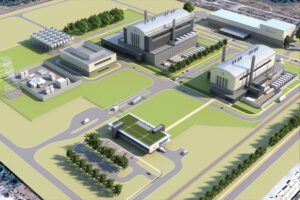 |
In drought-prone Southern California, Burbank Water and Power has implemented a groundbreaking stormwater capture and reuse system that saves more than eight million gallons of water annually. This award-winning project not only enhances operational reliability and sustainability, but also serves as a model for urban industrial water conservation.
In the arid landscape of Southern California, water is not merely a utility—it is the lifeblood that sustains millions of residents, numerous businesses, and the region’s economic vitality. The Greater Los Angeles area, which includes the City of Burbank, faces an ongoing challenge that has only intensified with climate change: securing adequate water supplies while managing growing demand and increasingly unpredictable precipitation patterns. With the region receiving an average of just 15 inches of rainfall annually, every drop becomes precious.
The San Fernando Valley, where Burbank sits, exemplifies the complex water management challenges facing Southern California communities. The city normally relies on a combination of imported water from the State Water Project and Colorado River Aqueduct, local groundwater, and recycled water to meet its needs. However, with periodic droughts, regulatory restrictions on imported water, and the imperative to protect groundwater aquifers from overdraft, Burbank—like its neighboring municipalities—must continuously seek creative solutions to maximize water efficiency and develop alternative sources.
For power plants, water conservation takes on added significance. These operations require substantial volumes of water for cooling and other essential functions, making them both major consumers and potential conservators of this precious resource. Against this backdrop, projects that demonstrate measurable water savings deserve recognition and replication.
Magnolia Power Plant Leads Conservation Efforts
The Magnolia Power Plant (MPP) represents exactly the type of critical infrastructure where innovative water management can yield substantial benefits—not just for the facility itself, but for the broader community it serves. MPP is a 310-MW combined cycle electrical power generating facility located in Burbank, California. The station consists of a GE 7FA.03 gas turbine, a three-pressure-level heat recovery steam generator (HRSG), and a GE A14 steam turbine. MPP went into commercial operation in 2005. It is owned by the Southern California Public Power Authority (SCPPA), operated by Burbank Water and Power (BWP), and serves the cities of Anaheim, Burbank, Glendale, Pasadena, Cerritos, and Colton.
MPP operates under a site lease agreement at a 22-acre campus managed by BWP. In 2024, BWP undertook a campus stormwater improvement project, which involved modifying the existing storm drain piping to redirect stormwater, which previously discharged to the Burbank Western Channel, into a new 277,000-gallon underground storage and infiltration facility. The project is estimated to save more than eight million gallons of water annually and embodies the innovative spirit and environmental stewardship that Southern California needs to thrive in an era of water scarcity. As such, POWER has recognized MPP, and the plant’s team of owners, operators, and project participants, with its 2025 Water Award.
Great Support from the Community and Project Partners
SCPPA’s cost for the project was directly proportional to the area of the BWP campus that is occupied by the plant. Therefore, participant cities were required to approve the budget for MPP’s portion of the project cost. The project was ultimately ratified by the coordinating committee as part of the overall budget approval process and recommended by the operating committee. As the operating agent for the project, BWP took on most of the responsibilities for the project, while regularly updating participant cities on progress at quarterly operating committee meetings.
“The project required a lot of planning due to California Environmental Quality Act [CEQA] permitting requirements,” Sean Kigerl, power production engineer with BWP, told POWER. “It took about two years to get through the permitting, so plenty of planning needed to take place at the front end to get the project implemented.”
The local community was engaged through public notification as part of the CEQA process. “The project’s CEQA determination was advertised in the local newspaper and a city council meeting was held to formally adopt the CEQA and authorize the project,” explained Frank Messineo, power production manager with BWP. Messineo noted that the project is part of BWP’s EcoCampus, which is a focus for tours and other events, so it got plenty of attention. “We received a lot of positive feedback when discussing the project during campus tours,” Messineo said.
BWP worked with MNS Engineers Inc. throughout the duration of the project. At each step, including the feasibility study, design, permitting, construction management, and more, MNS was involved and assisted BWP to ensure the project was successful. Other firms that provided valuable legal and CEQA/environmental permitting support included Sapphos Environmental, Brownstein Hyatt Farber Schreck LLP, and Yorke Engineering. Construction, meanwhile, was handled by Toro Enterprises Inc., while major components were purchased from Oldcastle Infrastructure, Multi W Systems Inc., and Trench Shoring Co.
The multi-year project was a collaborative effort and many BWP employees contributed. In addition to Kigerl and Messineo, Senior Environmental Engineer Claudia Reyes, Environmental Engineer Wendy Hsiao, Principal Electrical Engineer Jeff Fan, Senior Engineering Technician Matthew VanPuyvelde, Assistant Power Production Superintendent Nicholas Hammett, and Assistant Power Production Superintendent Mario Bautista were all vital to the project’s success.
The System in a Nutshell
The storage capacity for the project was precisely calculated to capture a 24-hour, 85th-percentile storm event—a sizing standard that aligns with Los Angeles Regional Water Quality Control Board requirements under the facility’s Industrial General Permit. This design threshold ensures the system can handle the majority of storm events while providing a controlled overflow mechanism for exceptional weather. When storms exceed the system’s capacity, water passively overflows to the Burbank Western Channel, maintaining flood protection for the surrounding area.
Assuming Burbank receives an average amount of rainfall annually, the system has the potential to capture approximately 8.2 million gallons of stormwater each year. While this represents only a small percentage of the plant’s annual cooling water needs, the contribution is significant both environmentally and operationally.
Water quality was a paramount concern in developing the system, requiring extensive analysis of stormwater samples collected over several years to characterize the campus runoff. Based on this data, BWP implemented a nutrient separating baffle box (NSBB) as the primary pretreatment system. This advanced, high-flow, multistage treatment technology has been proven effective over more than two decades of service at other facilities, and achieves 100% capture of trash and debris larger than 5 millimeters in size, while meeting California Water Board requirements for stormwater treatment.
The pretreatment process ensures captured water meets the quality standards necessary for cooling tower makeup water. Since biological growth represents the primary concern for cooling tower applications, the system includes monitoring and treatment protocols to maintain adequate free chlorine levels in the raw water storage tank.
The project incorporates comprehensive monitoring technology to track both water quantity and quality. An influent flowmeter measures the volume and flowrate of water entering the system, while the underground storage facility features float switches and submersible level sensors that monitor water levels and can automatically activate two 800-gallon-per-minute discharge pumps when needed.
 |
|
1. Infiltration piping is shown here during construction. The system allows high-quality treated stormwater to be released safely to the environment. Courtesy: Burbank Water and Power |
Downstream monitoring includes an effluent flowmeter that tracks water transferred to the raw water storage tank for cooling tower use. For environmental protection, lysimeters installed beneath the infiltration basin (Figure 1) sample water that infiltrates into the ground, ensuring that any water reaching local groundwater meets drinking water standards.
The system’s innovative design provides operational flexibility through its dual-purpose functionality. When the power plant is operating, captured and treated stormwater supplements the cooling tower makeup water supply, reducing reliance on other water sources. During plant downtime, the same water can be infiltrated into the ground, directly replenishing local groundwater resources that would otherwise not benefit from stormwater that typically flows to the ocean via the Burbank Western Channel.
The project’s most significant engineering challenge involved separating the BWP campus drainage from approximately 22 acres of offsite industrial and light commercial runoff that had historically mixed with the campus system underground. This separation was essential to prevent contamination risks and avoid oversizing the treatment system. The solution required constructing a new storm drain with direct discharge to the Burbank Western Channel—a complex undertaking that demanded permits from multiple agencies including the U.S. Army Corps of Engineers, Los Angeles Regional Water Quality Control Board, California Department of Fish and Wildlife, Los Angeles County, and the City of Burbank.
Construction logistics added another layer of complexity, as work in the public right-of-way required all activities to occur during nighttime hours to minimize disruption to the surrounding community. Despite these challenges, the system was successfully completed in November 2024, demonstrating the feasibility of sophisticated water management retrofits in urban industrial settings.
Measuring Success
 “BWP’s mission is to safely provide reliable, affordable, and sustainable utility services for our community,” Mandip Samra, general manager of BWP, explained. “This project covers all three areas of BWP’s mission.” As previously mentioned, MPP is situated within BWP’s EcoCampus, which incorporates sustainable elements, softens the exterior look of the site to appropriately blend into an urban setting, and maintains its industrial purpose to continue to add economic vitality to the community. “This project directly fits into the EcoCampus vision,” Samra added.
“BWP’s mission is to safely provide reliable, affordable, and sustainable utility services for our community,” Mandip Samra, general manager of BWP, explained. “This project covers all three areas of BWP’s mission.” As previously mentioned, MPP is situated within BWP’s EcoCampus, which incorporates sustainable elements, softens the exterior look of the site to appropriately blend into an urban setting, and maintains its industrial purpose to continue to add economic vitality to the community. “This project directly fits into the EcoCampus vision,” Samra added.
Several goals have been achieved as a result of the project. Perhaps most important has been an improvement in plant reliability. By providing an alternative source of cooling water, MPP is better able to handle recycled water production interruptions without disrupting operations. Meanwhile, availability has also been improved.
Importantly for customers, there has been a cost savings, which is reflected in the annual recycled water budget. Furthermore, sustainability has been enhanced. The project allows the amount of stormwater that is infiltrated to be precisely calculated, which helps quantify the benefits not only for the plant, but also for the community. “The captured water offsets recycled water purchases and provides positive benefits to MPP’s overall water use budget,” Kigerl concluded.
—Aaron Larson is POWER’s executive editor.










